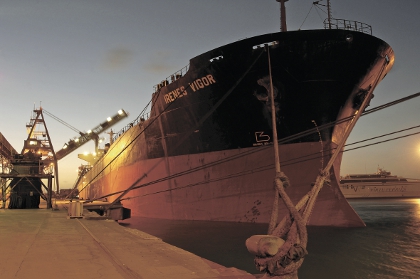

BHP Billiton says growth in Chinese demand for iron ore appears to be flattening out but fellow mining giant Rio Tinto is expecting Chinese demand to outstrip supply over the next seven years.
Dismissing concerns about a slow-down in China's economy, BHP Billiton Iron Ore president Ian Ashby says he's confident the Asian superpower will meet its five-year economic growth targets.
"The pie is big and they are still growing their steel industry," Mr Ashby told reporters on the sidelines of the Global Iron Ore and Steel Conference in Perth.
Growth in Chinese demand for iron ore had in recent years been in double digits, but would slip into single digits "if it's not already there", Mr Ashby said.
A Fairfax report this morning noted that chairman Jacques Nasser had told investors the miner was re-evaluating its big spending plans amid a more cautious outlook for commodities demand.
Mr Ashby indicated that BHP Billiton hadn't made any decision yet, but was poised to respond to slowing demand.
"We haven't slowed down any of the work that allows us to make a decision."
Mr Ashby said he expected China's steel production capacity would reach up to 1.1 billion tonnes by 2025, up from about 700 million tonnes currently.
He would not comment specifically on the outlook for the iron ore price, but said there was a "floor" at $US120 per tonne, compared to about $US145/t currently, based on the cost of Chinese domestic iron ore production.
Rio Tinto said the world's iron ore mines needed to produce an extra 100 million tonnes (Mt) annually to meet Chinese demand for the next seven years.
Global annual iron ore production currently stands around 1.3 billion tonnes, with about 450Mt of that coming from China's domestic mines.
But the head of Rio's expansion projects David Joyce on Tuesday said an extra 500Mt was needed to meet expected demand growth before 2019.
A further 200Mt was required to replace volumes lost when companies exit high-cost iron ore operations.
"Of the 700Mt that I just mentioned, Rio Tinto expects to capture at least 25 per cent," he told the Global Iron Ore and Steel Forecast conference in Perth.
Global annual iron ore production currently stands around 1.3 billion tonnes, with about 450Mt of that coming from China's domestic mines.
Mr Joyce said Rio was confident of a soft landing in China and that the miner's iron ore capacity expansion in Western Australia's Pilbara region was on time and budget.
This quarter, Rio Tinto's annual capacity to produce the steel-making commodity will increase from 225Mt currently to 230Mt.
While its plan to expand to 353Mt per annum remained subject to board approval, the company had begun sourcing long-lead items.
"Our mine plan presently extends to 2069, which is complemented by a sales and marketing plan to 2050," Mr Joyce said.
"Our present planning suggests that grades can be maintained across our mines portfolio and, at a rate of 353 million tonnes per annum, we would be able to support our Pilbara Blend products until at least the year 2045."














